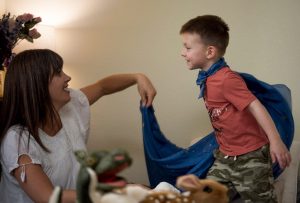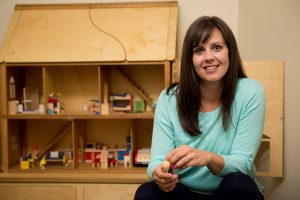Blog by Rachael Pasemko, RSW, RCC, RPT-S
As a play therapist, Somatic Attachment Psychotherapy (SAP) has expanded my practice and become the framework I use to conceptualize my clinical practice. I understand the children, their families, and their life experiences through a lens of early attachment connections, injuries and repairs. Play therapy is an imaginal, right brained modality and therefore often ambiguous, difficult to measure or interpret, which makes it challenging to communicate progress to caregivers. Having a breadth of understanding of the Autonomic Nervous System (ANS), attachment theory and relational practice, internal working models (IWM), shame and chronic shame, embodiment, the intersubjective field, and working with the right hemisphere, makes the work more easily articulated and understood within a variety of theoretical and conceptual frameworks.
As a clinician, I favour a non-directive style of play therapy, meaning I follow the child’s lead, and we spend our time engaged in the activities chosen by the child. My work is a combination of Expressive Play Therapy, Synergetic Play Therapy, and Somatic Attachment Psychotherapy. I offer child clients an intentionally curated play space that includes puppets, sand tray 
My role in sessions can look simple to an untrained observer; like I am sitting with a child while they play in a lovely room; however, the work is actually clinically sophisticated and nuanced. My focus is on creating a safe-enough environment and therapeutic relationship where the child can relax into themselves, freely express their inner world, explore challenges, and share what it feels like to be them. My therapeutic stance is to offer co-regulation and opportunities for relational repair, and meet their expressions with acceptance and permission. At times, we work with symbols and metaphors that need to be witnessed and held in order to be transformed and integrated. At other times, we are attending to developmental needs and stages that have not been met, and that need support to progress.
Many children have easy access to the right hemisphere and its symbolic, metaphoric, and intuitively creative expressions. As a result, I seldom have to work past a “defended left hemisphere” (Quillman, 2012, p. 5), as often therapists must do in therapy with adults, and we frequently spend the therapeutic hour in the imaginal, both embodied and in the upper right hemisphere. I work with the imaginal as taught in SAP with the addition of three-dimensional play objects such as figurines, puppets, or a family of cats in the doll house.
When a child has experienced trauma, the play can be rigid, restricted, and repetitive. Bringing healing images into the trauma narrative at the right time, in the right way, can encourage the expression needed to transform and integrate. This integration expands the child’s window of tolerance, increasing their capacity for stress and emotions, resulting in a decrease in challenging behaviours. I may offer a tiny blanket to a baby that is repeatedly stuck in the trunk of a car. I might set up a hospital, if the child can tolerate that level of care, for the soldiers that are being annihilated. This aspect of my practice uses the language of symbols and metaphors to move difficult, unconscious, or disavowed material.
Much of my play therapy practice, as in SAP with adults, is a focus on the ANS. I observe the child’s physical body for cues, notice what sensations I am experiencing in my own body, as well as the themes in play that reflect the state of the child’s
Relational healing and repair, much of the focus of SAP, is also much of the work in my practice. Coming alongside a child with ANS dysregulation to support them to modulate the intensity and co-regulate is relational work that tends to early attachment disruptions, whereby the therapist is the “psychobiological regulator” (Carroll and Schore, 2001, cited in Gill, 2009, p. 362). Children experience co-regulation in my play room, and I work with their family system when it is available, intending that over time the child client is able to access co-regulation outside of therapy, and eventually an increase in their capacity for self-regulation. In working towards relational repair of attachment injuries, there is opportunity to use verbal and physical reflections to mirror the child back to themselves, disrupting their IWM and over time shifting their concept of self.
Bringing SAP into the playroom also brings an awareness to my own nervous system so I can be intentional about taking care of myself in the midst of the complicated experiences of my clients. In the intensity of hyperaroused play, where we are acting out traumatic material, the child’s projections often land on the therapist. Being killed in an intense sword fight repeatedly can leave a residue of dysregulation as there are real emotions in the play- real fear, helplessness, or terror. Having a strong capacity to regulate my ANS and understand the impact of working with trauma, and how to care for one’s self are key to longevity in this career.
Integrating SAP into my play therapy practice has resulted in deeper and more rewarding work for me and the children and families I meet with. By bringing in a comprehensive focus that weaves the body, attachment and relational repair, and applying it in developmentally appropriate ways, in concert with my play therapy, I have an increased therapeutic canvas to understand and relate to my clients and their families. This comprehensive understanding of early trauma and the reparative responses needed, allows me to access the core of the child’s wounding which is often at the foundation of the behavioural symptoms that brought them to my play room initially.
If your interest in piqued, and you want to know more about Somatic Attachment Psychotherapy Trainings, here’s a link to the Somatic Attachment Psychotherapy training page
References:
Gill, S. (2009). The therapist as psychobiological regulator: Dissociation, affect attunement and clinical process. Clinical Social Work Journal, 38(3), 260 – 268.
Quillman, T. (2012). Neuroscience and therapist self-disclosure: Deepening right brain to right brain communication between therapist and patient. Clinical Social Work Journal. 40, 1 – 9
Rachael Pasemko, RSW, RCC, RPT-S is a play therapist and group practice owner in Kamloops, BC. She loves working with the language of symbols and metaphors, integrating the body into the therapeutic process, and supporting children and families to find more ease. Rachael co-facilitates a neuroscience based parenting group that teaches parents what play therapists do, offers consultation to other play therapists, and can be reached at rachaelpasemko@gmail.com
